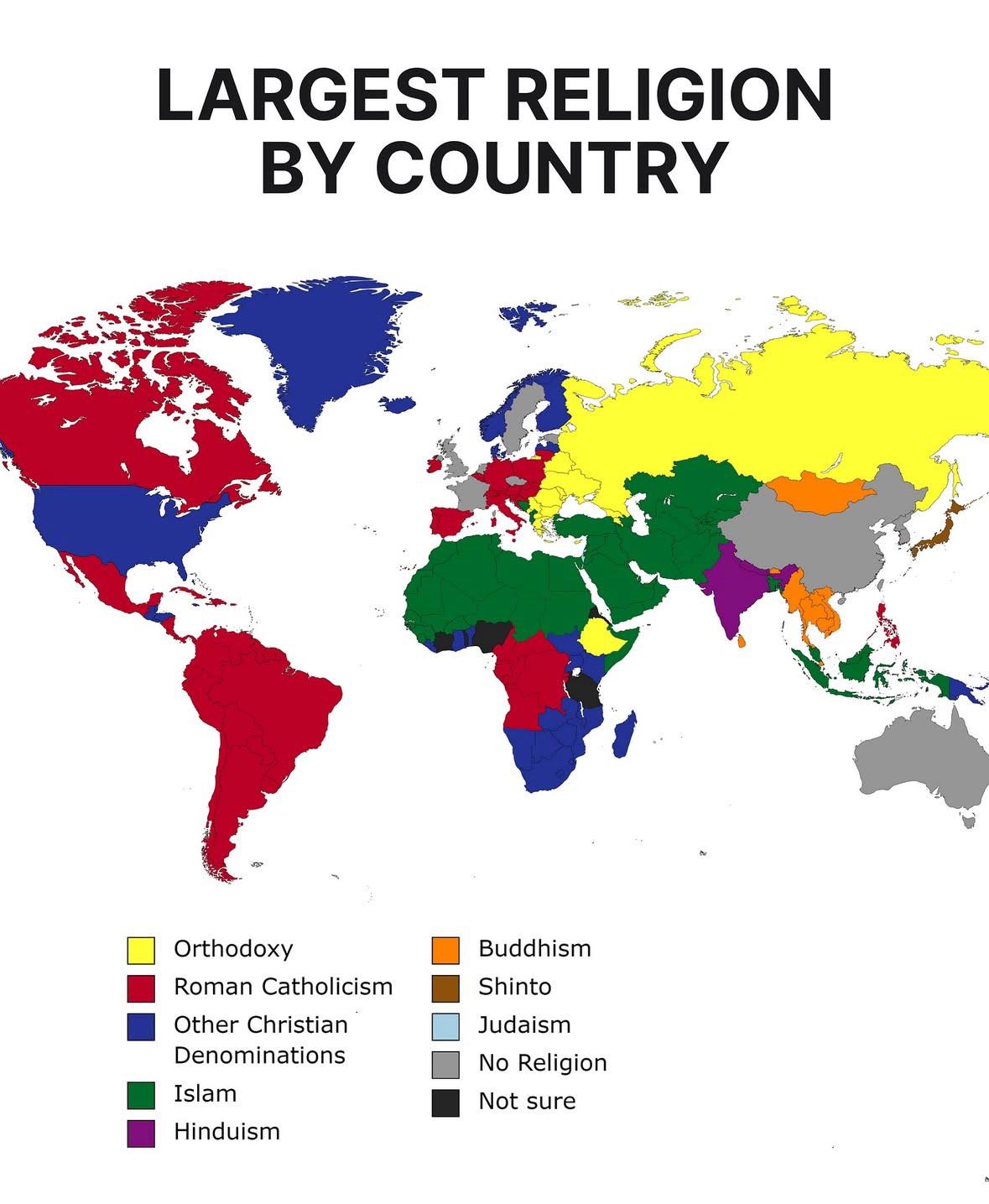Largest Religion by Countries Map


Marcus Rodriguez
Historical Geography Expert
Marcus Rodriguez specializes in historical cartography and geographic data analysis. With a background in both history and geography, he brings unique...
Geographic Analysis
What This Map Shows
The "Largest Religion by Countries Map" provides a comprehensive visual representation of the predominant religions practiced across the globe. Each country is color-coded to indicate the largest religion within its borders, offering an insightful glimpse into the religious landscape of our world. This visualization not only highlights the diversity of faiths but also reflects historical, cultural, and sociopolitical influences that shape each region's spiritual identity.
Deep Dive into Global Religions
When we talk about the world's largest religions, we're primarily referring to major belief systems such as Christianity, Islam, Hinduism, Buddhism, and more. Each of these religions has a unique origin story, sacred texts, and practices that have evolved over centuries.
Christianity, with over 2.3 billion adherents, is the largest religion globally. Its roots trace back to the life and teachings of Jesus Christ in the 1st century CE. Today, it has a significant presence in Europe, the Americas, and parts of Africa. Interestingly, the influence of Christianity is not only spiritual but also cultural, affecting everything from art to law.
Islam follows closely behind, with approximately 1.9 billion followers. Originating in the 7th century CE in the Arabian Peninsula, Islam has rapidly spread across regions, particularly in the Middle East, North Africa, and parts of Asia. The religious practices of Islam, centered on the Five Pillars, highlight the faith’s emphasis on community and devotion.
Hinduism, with around 1.2 billion practitioners, boasts a rich tapestry of beliefs and rituals. Predominantly found in India and Nepal, Hinduism is often described as a way of life, encompassing a variety of deities, philosophies, and customs that reflect the diversity of the Indian subcontinent.
Buddhism stands with approximately 520 million followers, primarily in East and Southeast Asia. Founded by Siddhartha Gautama (the Buddha) in the 5th century BCE, Buddhism emphasizes the path to enlightenment through practices such as meditation, moral conduct, and mindfulness.
What's fascinating is how these religions coexist and interact in various regions. For example, in Indonesia, the world's most populous Muslim-majority country, you'll also find a blend of traditional animist beliefs and Hindu influences, showcasing how religions can evolve and merge over time.
Regional Analysis
The map reveals stark regional differences in religious adherence. In North America, Christianity dominates, with a significant number of Protestants and Catholics. However, the rise of secularism and non-religious individuals is noteworthy, especially in urban centers.
In contrast, the Middle East is predominantly Islamic, with countries like Saudi Arabia and Iran showcasing the major sects—Sunni and Shia— and their political implications. Interestingly, Israel presents a unique case with Judaism being the largest religion, while also being home to a significant Muslim and Christian population.
Europe showcases a diverse religious landscape, with Christianity still holding sway but witnessing a notable increase in secularism and the rise of other belief systems. Countries like Sweden and the Czech Republic illustrate this trend, where a growing percentage of the population identifies as non-religious.
In Asia, the presence of Hinduism in India is profound, but the map also highlights areas where Buddhism thrives, such as in Thailand and Myanmar. Moreover, the coexistence of various religions in countries like India presents a complex tapestry of faith, where inter-religious dialogue and conflict often play a crucial role in societal dynamics.
Significance and Impact
Understanding the distribution of the world's largest religions is essential for several reasons. Firstly, it helps us comprehend cultural practices, social structures, and even political landscapes in different countries. For example, countries with a predominant religion often reflect its values in governance, law, and education.
Moreover, as globalization continues to shape our world, interfaith dialogue and understanding become crucial. With migration and cultural exchange, we see a blending of traditions, which can lead to both enriching experiences and tensions. For instance, the rise of Islam in Europe has sparked discussions on integration and multiculturalism, highlighting the need for open dialogue.
Looking ahead, projections indicate that Islam may soon outpace Christianity in terms of growth due to higher birth rates in Muslim-majority countries. This shift may influence global geopolitics, economic dynamics, and cultural exchanges in profound ways, underscoring the importance of understanding these religious patterns.
In conclusion, the "Largest Religion by Countries Map" serves as a vital tool for understanding the rich tapestry of global faiths. By examining how religions shape societies and interact with one another, we gain insight into the complexities of our world, fostering a greater appreciation for the diversity of human belief and experience.
Visualization Details
- Published
- October 21, 2025
- Views
- 26
Comments
Loading comments...